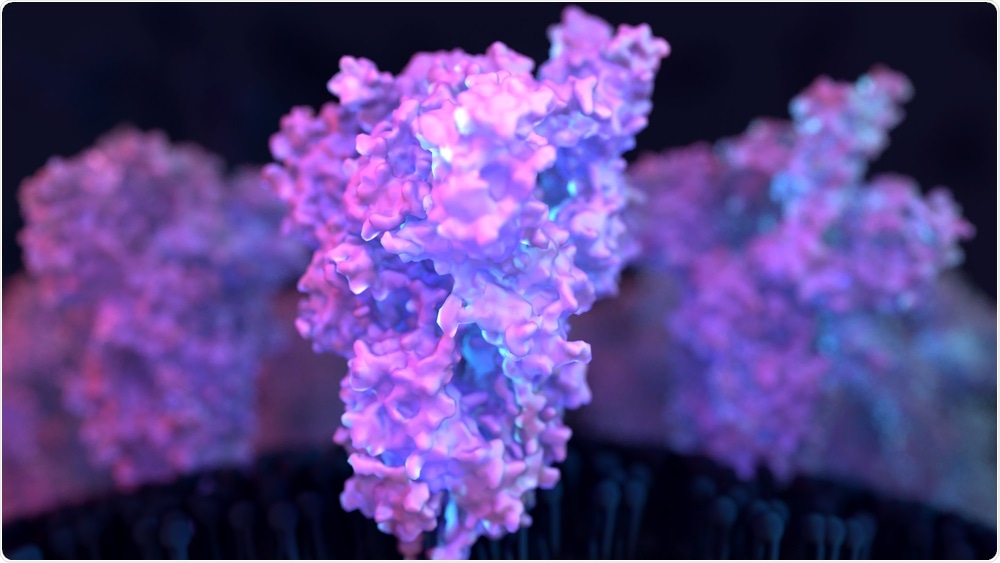Considering the recent COVID-19 pandemic, significant investigations are being made to find out how the SARS-CoV-2 Spike protein binds to a human cell at the time of the infection process, as this information is beneficial in designing therapeutics and vaccines.

Spike Protein of SARS-CoV-2 Virus. Image Credit: Design_Cells/Shutterstock.com
A research team has now identified more sites on the Spike protein that may help explain how specific mutations render emerging variants more infectious and could also be utilized as additional targets for therapeutic intervention.
Significant research is underway to examine how the receptor binding domain (RBD) at the tip of the club-shaped SARS-CoV-2 Spike protein attaches to an ACE2 receptor on a human cell, but little is known about the other changes that occur in the Spike protein as a result of this attachment. We have uncovered 'hotspots' further down on the Spike protein that are critical for SARS-CoV-2 infection and may be novel targets beyond the RBD for therapeutic intervention.”
Ganesh Anand, Associate Professor of Chemistry, Penn State
Anand and his collaborators employed a process, known as amide hydrogen-deuterium exchange mass spectrometry (HDXMS), to observe what occurs when the SARS-CoV-2 Spike protein attaches to an ACE2 receptor.
HDXMS utilizes deuterium oxide (D2O) or heavy water—a non-radioactive, naturally occurring water isotope that forms from deuterium or heavy hydrogen, as a probe for plotting proteins. In such a case, the researchers placed ACE2 receptors and SARS-CoV-2 Spike protein in heavy water and acquired ACE2 footprints on the Spike protein.
If you put the Spike protein and ACE2 receptor into a solution that's made with D2O, the surfaces and more floppy regions on both proteins will more readily exchange hydrogens for deuterium, compared to their interiors. And footprints of each protein on the binding partner can be readily identified from areas where you see little deuterium and only detect normal hydrogen.”
Ganesh Anand, Associate Professor of Chemistry, Penn State
With the help of this method, the researchers established that binding of the ACE2 receptor and the Spike protein is required for furin-like proteases—a class of human enzymes—that act to cut off the tip, known as the S1 subunit, of the Spike protein, which is the subsequent step in the virus’ infection of the cell. The results have been published in the eLife journal on February 8th, 2021.
The Spike proteins on the surface of the virus swivel to search and latch onto the ACE2 receptor. ACE2 can be likened to a hand holding strands of hair—the Spike protein clusters. Binding to Spike stabilizes it so it can be cut by furin protease scissors. After furin proteases clip the protein, the part that remains—the S2 subunit—is what fuses with the cell's membranes, allowing entry into the cell.”
Ganesh Anand, Associate Professor of Chemistry, Penn State
Anand observed that scientists have already learned much about the binding between the Spike protein and the ACE2 receptor; however, no one knew how this binding transmitted the message to the furins to snip off the protein, until now.
Anand explained that the phenomenon is referred to as allostery, which means “action at a distance.”
Anand continued, “Our findings show ACE2 receptor binding to SARS-CoV-2 Spike protein causes long-range changes and allosterically enhances protease cutting at the distal S1/S2 cleavage site.”
Now, scientists are focusing solely on therapeutics that inhibit the Spike protein from attaching to the ACE2 receptor, added Anand.
“In this paper, we’re suggesting that's not the only vulnerability that can be targeted. Maybe the S1/S2 cleavage that is necessary for furin cleavage can serve as a new target for inhibitory therapeutics against the virus. This study also may help in explaining how mutations in emerging variants might alter dynamics and allostery of ACE2 binding, potentially increasing infectiousness of the SARS-CoV-2 virus,” Anand concluded.
Source:
Journal reference:
Raghuvamsi. P. V., et al. (2021) SARS-CoV-2 S protein: ACE2 interaction reveals novel allosteric targets. eLife. doi.org/10.7554/eLife.63646.